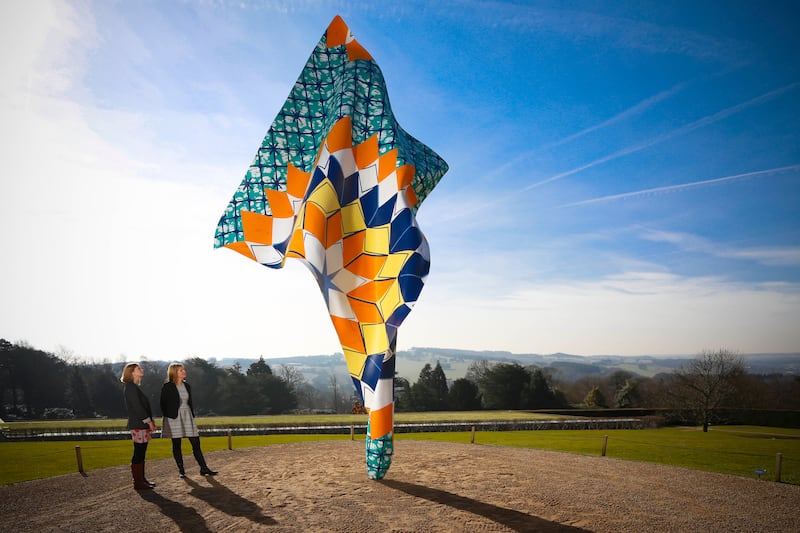Imagine a handkerchief appearing from a magician’s hand: the bottom corner thin and rolled, the top half unfurling in the wind. Since 2014, British-Nigerian artist Yinka Shonibare has made fibreglass sculptures that picture the air in motion. One of these will be appearing for the first time at Expo 2020 Dubai and will remain at the site as a permanent public work.
“I see wind as a metaphor for migration," says Shonibare. "For people – enslaved people – moving by sea."
The idea for the sculptures evolved from his investigation of Dutch East India fabric – Shonibare's key subject, whose bright patterns furnish the motif on the fibreglass sculptures.
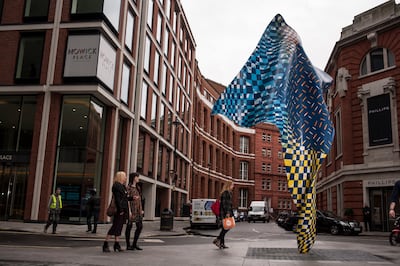
The textiles are synonymous with African identity, but over the past 30 years – mostly owing to Shonibare's work – they’ve been revealed as a slippery symbol: an emblem embraced as part of Africa, but in reality part of the story of colonialism.
Shonibare first encountered the fabric's history when he was in art school in the late 1980s. He was making pieces about the international issues of the day – and it being the Cold War era, they focused on Russia. His art teacher pressed him, however, to create artworks about Africa, as the British-born artist had grown up in his parents’ country of Nigeria.
“I said no, I don’t have to think strictly about about Africa, just because I'm from Africa,” he says. “But that’s when I started to ask myself about identity: what does it actually mean, in the modern world? In our real lives, we might drive a Japanese car, have Indian meals and watch American movies. How do you then describe the identity of a person who lives in that kind of way?”
Unbeknownst to him, the Dutch East India textiles became a perfect means to represent a more layered understanding of modern identity. While he first associated the fabrics with the African women who wore them, as he learnt more, he realised that the wax-cotton printed fabric was not ethnically African. Instead it came from the Indonesian batik tradition, carried on British merchant ships and sold to markets in Africa. The symbol of African identity was itself imbued with its colonial history.
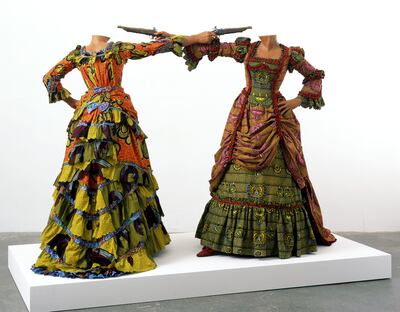
Shonibare seized on the paradox. With a knack for stagecraft, he dressed small mannequins in the fabric, cutting them into Victorian styles. He arranged the wearers in scenes of leisure, often laced with violence. In effect, he said the quiet part out loud: 19th-century British wealth came off the back of colonialism.
The idea was malleable, and Shonibare pressed it into sculptures, films and performances that have made him one of the most important artists in the UK. This year, he has curated the prestigious Royal Academy of Arts Summer Exhibition, which opened earlier this month. Wind Sculpture III, at Expo 2020 Dubai, is part of this legacy, but it also comes from another stage in his artistic evolution: his first public commission, Nelson's Ship in a Bottle, for the fourth plinth at Trafalgar Square in London.
Trafalgar Square, an expansive, pigeon-packed plaza dominated by a tall, spindly column holding the figure of Admiral Lord Nelson, was laid out in 1840 to commemorate the Battle of Trafalgar, in which British ships, under Nelson’s command, defeated the French and Spanish fleets. In architect Charles Barry's balanced, Neoclassical design, four plinths mark the corners of the square, each intended for a dignitary: two smaller ones featuring military heroes standing upright, and two rectangular ones for former kings, seated on horseback. But with three sculptures made, the money for Trafalgar Square ran out. So the last plinth, intended for William IV, remained empty for 150 years.
Then, in 2005 the Mayor of London began commissioning contemporary artists for a rotating, two-year sculpture on the site. The Fourth Plinth has become one of London’s most popular programmes, and in 2010, Shonibare was chosen to design a work.
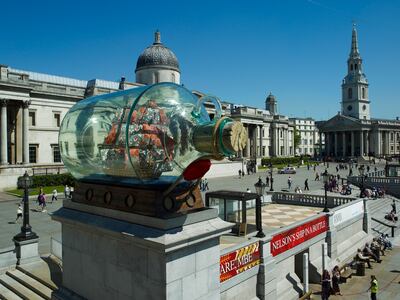
Lifting meaning out of his context, he made a scale replica of Nelson’s ship, the HMS Victory, and encased it like a kitschy trinket in a bottle. He rendered the grand ship’s 37 sails not in white canvas but in the bright patterns of African textiles, by that point an unmistakeable symbol of colonial identity.
“Britain won that battle at sea, and as a result of that victory, Britain had more freedom of the seas to expand its colonies,” he says. Britain was able to parlay its maritime access, in terms of troops and trade, to increase its African and Asian presence.
For the Wind Sculptures, Shonibare honed in on the sails themselves to picture wind, migration and trade – the crucially important but invisible vectors in creating modern identity.
“The British colonial project was mostly done by boats, from the movement of enslaved people to goods,” he says. “The Wind Sculptures capture that movement and the movement of migration, but then the work is also talking about sculpture: what can we make sculpture about? Of course, it's hard to make sculpture of wind, but I could capture the movement of wind through the fabric.”
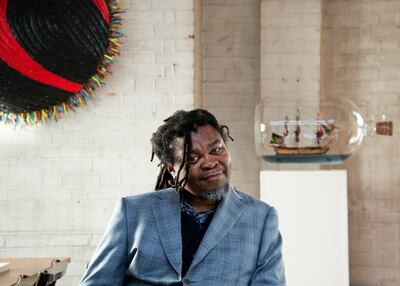
The version for Expo 2020 Dubai rises six metres in the air from a stainless steel support. Though nine Wind Sculptures exist, the pattern is new to the UAE and moreover, so is Shonibare’s work. Somewhat astoundingly, given the relevance of Shonibare’s focus on global identities to the UAE, his work has never been exhibited in the country. The Guggenheim Abu Dhabi has one of his works in its collection, but it has not yet been shown publicly.
For Shonibare, the Middle East has been plagued by many of the same problems that Africa faced after colonialism, having been carved up into contested nations.
“The Middle East and African countries have been around for thousands of years, but the nation-state is a relatively new concept,” he says. “And so most of the ex-colonies had to then create their own national identities. The result of that is citizens who have to fit into the framework of an action that historically, as we know, has created difficulties, because people have been artificially forced into geographical areas.”
Shonibare’s sustained engagement with colonialism is also a reminder of how long the art world has been wrestling with these concerns, even if they appear newly at the forefront of contemporary work. He demurred when it was suggested that he was an elder statesman or role model for younger artists of colour who are thinking through black British identity. Instead, he evinced a qualified note of optimism: a cyclical struggle, but one moving towards social justice.
“It’s inevitable that people of my generation would want to address those issues – because, quite frankly, historically, it's the first time that we actually have had a voice,” he says. “And when people lose power, they try to fight back. That’s a natural thing. I'm not surprised when people fight back to retain the amazing advantages they've had historically. But I see it as an ebbing away.”
